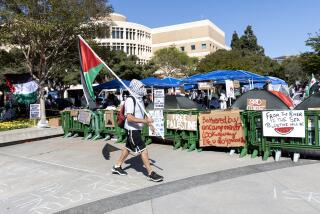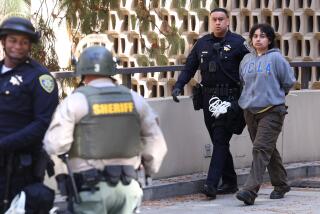In an era of USC-UCLA pranks, one stood out. Sixty years later, its mystery is solved
A septuagenarian professor and former USC student, having caught wind of a forthcoming story in the Los Angeles Times, recently sent a cryptic email to the newspaper.
Sixty years ago, the professor, Dayle Barnes, belonged to an organization at USC called the Trojan Squires, which pulled off one of the most memorable in a long line of pranks in USC’s rivalry with UCLA. For the game at the Coliseum in 1957, UCLA’s student section had planned a series of card stunts. The UCLA students were to hold up placards that would combine to form Bruins-friendly words and pictures.
Except when the students actually did hold up their cards, they had been altered by a band of USC saboteurs. In each stunt, the unwitting UCLA students revealed a different pro-USC message. It caused such a stir that Sports Illustrated wrote about the prank — without interviewing its creators.
Barnes wrote in the email that reporting about the prank’s creators would be a “tough assignment” given “the complete secrecy with which the clandestine group of Trojan Squires” operated.
He explained that though he was part of the Squires, the prank was conceived and executed by a small, elite unit within the organization, operating under deep cover. Barnes didn’t know their identities.
“That is not to deny, however, that more than a few of that year’s membership were eminently qualified, by background and personality, successfully to conduct a covert assignment,” he wrote.
The mystery endured among the dwindling population of USC and UCLA alumni who keep score of such pranks. There would be no answer for 60 years.
Until now.
The saboteurs, it turned out, were a group of eight to 10 sophomores. Since, they had become officers in the Air Force and Marines, or lawyers or businessmen.
One became the majority leader of the California Assembly — “Not using pranks,” the prankster turned politician, Walter Karabian, said.
Three of them — Karabian, Steve Marienhoff and Mike Loshin — recently spoke on the record about the prank for the first time. Two more, Dave Visel and Jerry Van Wert, recorded a video interview with the school, a copy of which was provided to The Times by Claude Zachary, an archivist and manuscript librarian at USC.
It seems a strange, trifling matter for the school to record for posterity. But at a time when inter-school pranks are at an ebb, lacking the creativity or flair of past generations, their story presents a question: Why prank at all?
The action was part of an escalation of hostilities that began with USC’s stealing of the UCLA victory bell in 1941, and culminated in a high (or low) point: A group of UCLA students, in 1958, renting a helicopter, hovering over USC’s campus and air-dropping several hundred pounds of manure.
In 1957, on the eve of the card prank, USC students held a late-night rally at the Sheraton Townhouse hotel — except it was not a rally, really. It was more an excuse to wake up the UCLA players who were staying at the hotel, according to the Daily Trojan newspaper. Earlier that week, two UCLA students sneaked onto USC’s campus, likely intent on trickery. They were intercepted by USC students, who shaved their heads and one eyebrow each.
The Squires had dreamed up the card prank a month before. The plan required some specialized skills and, as Sports Illustrated wrote, “modest amounts of petty theft, espionage, impersonation and forgery.”
Spies infiltrated the UCLA planning committee to get the specs for the placards and to purloin one of the master instruction cards. The Squires also needed someone with access to a printer. Marienhoff’s father ran a printing shop. So even though he was not a member of the Squires, he became part of the team, sworn to secrecy.
“It was like a CIA-type thing,” Marienhoff said.
When the day of the game came, seven Squires wearing UCLA colors and with the placards smuggled under their shirts showed up early. They found a spot in the upper part of the student section seven rows tall by nine seats wide and swapped out the UCLA cards for their own. Only an usher was there.
Nervous, Karabian tried to sweet talk him.
“I said, ‘We’re really going to kick those Trojans’ [butts] aren’t we today?’ ” Karabian said. “He turned to me and said, ‘Look man, I go to USC dental school. I’m just working here today.’ ”
They were in the clear. The group finished, then hurried back to the USC side to wait and watch.
When UCLA began its card stunts, the other side of the stadium erupted.
In a corner of the section was a cardinal and gold rectangle, stamped like a tattoo. For most variations, the cards spelled out “SC.”
Other times, they were gleefully simple: “HA,” or just: “HI” in USC colors.
The UCLA students kept cycling through their routine. Eventually, someone near the field noticed. But they couldn’t stop it.
“The good thing about the card stunt is you’re like a robot,” Loshin said. “You read the instruction, you put the card in front of your face, and you don’t know what’s going on.”
The secrecy persisted even afterward. The group was afraid of repercussions — they’d heard that the unfortunate UCLA students in the affected section were harassed by those who thought they were USC plants. But mainly the group was afraid they’d be kicked out of school.
“Boy, were we scared,” Karabian said.
They didn’t feel safe until they graduated. But their time for publicity was gone. Most went separate ways. About a year ago, Karabian sought to reconnect the gang. But 60 years had left memories fuzzy. He couldn’t recall everyone who was involved. Was Marienhoff the spy? No, Visel said, it was Visel. Karabian went on a search to fill in the blanks.
One question remained: Why prank at all?
“Part of college life is doing things that don’t hurt anybody and that are creative,” Loshin said.
It is hard to imagine a hostile helicopter dumping manure onto a college campus would be met with shrugs today, but even more benign pranks have become taboo.
That’s a shame, Karabian says. He said his motivation for the trick was simple. Everybody on campus knew USC would lose. USC was 1-7. UCLA was 7-2. (Everybody was right: UCLA won 20-9.)
“We were doing anything we could to have a season that wouldn’t be the most humiliating in history,” Karabian said.
It was a way to feel as though they could make an impact.
The plot, he said, “gave us hope.”
Follow Zach Helfand on Twitter @zhelfand
More to Read
Go beyond the scoreboard
Get the latest on L.A.'s teams in the daily Sports Report newsletter.
You may occasionally receive promotional content from the Los Angeles Times.







